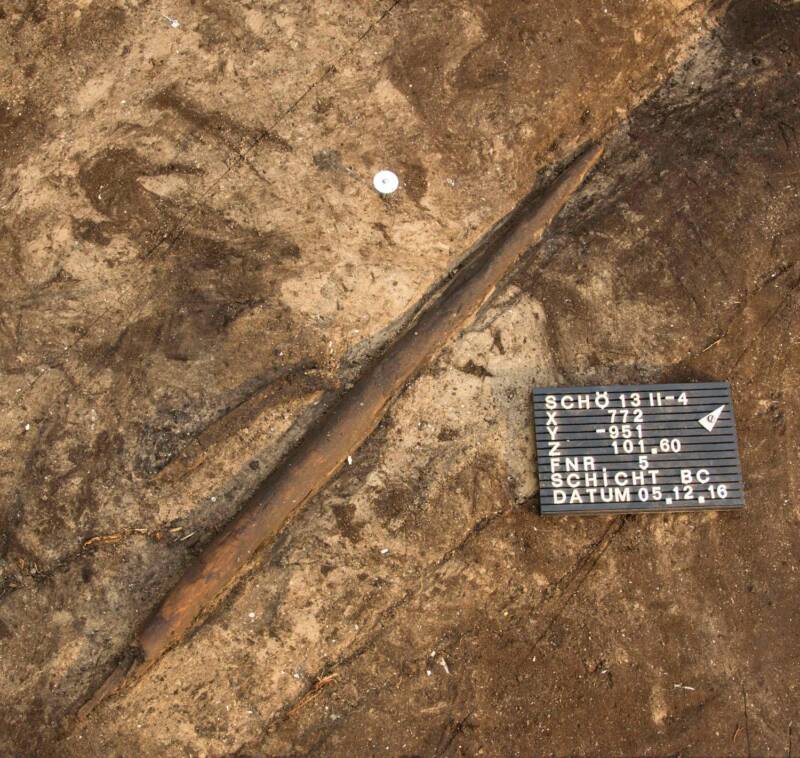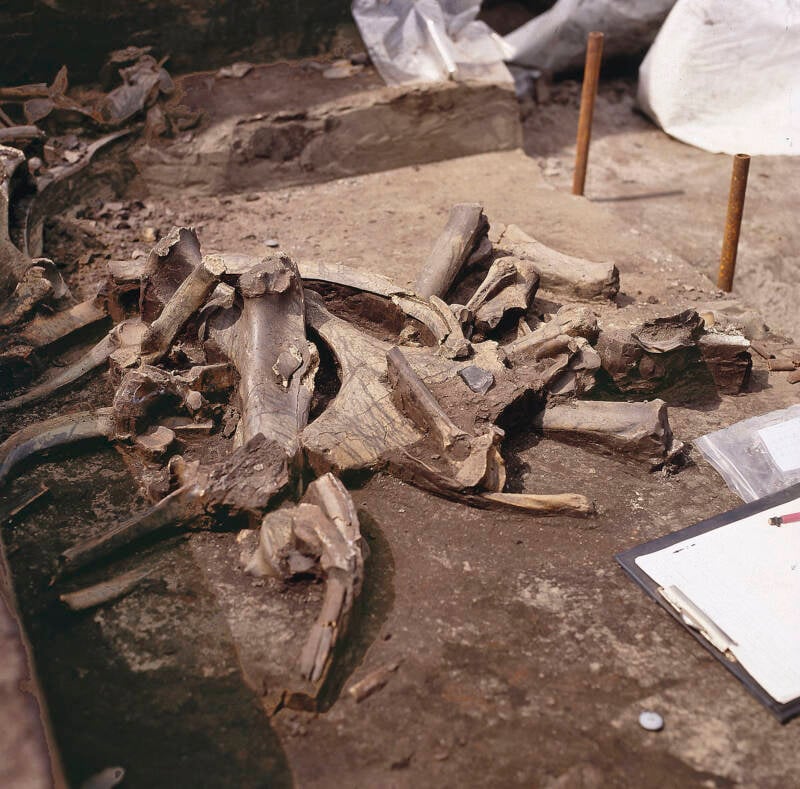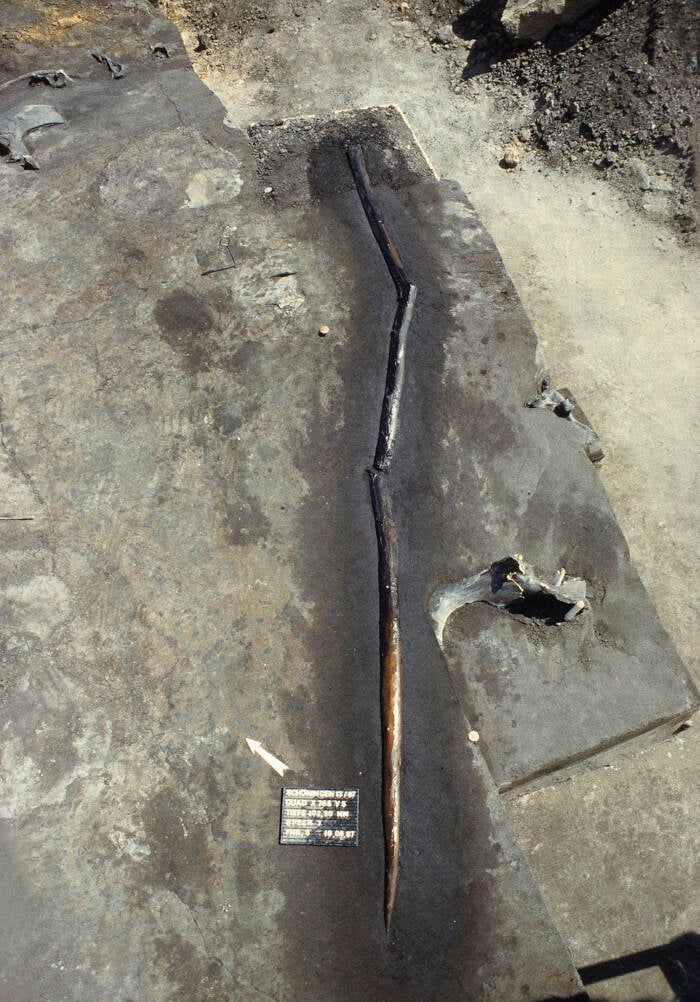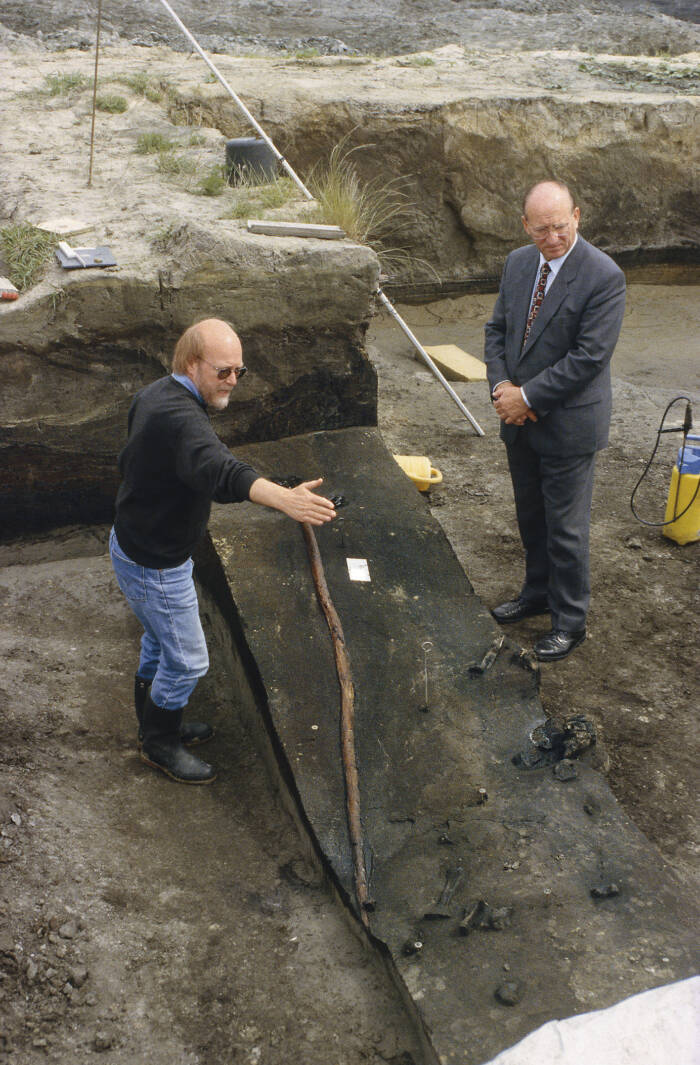Though they were previously believed to have been crafted by Homo heidelbergensis, new research suggests that prehistoric spears found in Schöningen, Germany were actually made by Neanderthals.

Alexander GonschiorThe prehistoric wooden spears found in Schöningen, Germany, now believed to be 200,000 years old.
Prehistoric wooden spears found decades ago in Schöningen, Germany were once thought to be around 300,000 years old. It was thus believed that they were made by an early human ancestor known as Homo heidelbergensis.
New research, however, suggests that the Schöningen spears are actually much younger than previously thought, likely dating back 200,000 years, and were in fact made by Neanderthals.
The Discovery Of Prehistoric Spears In The German Town Of Schöningen
The Schöningen spears are made of spruce and pine, measure six-eight feet long, and are among the oldest known hunting weapons ever found. They were first discovered more than 25 years ago in an open-pit coal mine alongside the remains of nearly 50 horses, which had likely been killed with the spears.

Wikimedia CommonsThe fossilized horse bones found near the spears.
When researchers first found the spears, they estimated that the site was between 300,000 and 400,000 years old, based on the ages of the sediment layers above and below. That estimate led researchers to suspect the spears had been made by Homo heidelbergensis, likely the last common ancestor of both Neanderthals and modern humans.
But according to a new report published in Science Advances, more recent research has changed the timeline of the spears’ construction and use. Now, based on dates obtained from snail shells at the site, researchers believe the spears may only be 200,000 years old, suggesting they were in fact created by Neanderthals.
This, researchers say, suggests that Neanderthal brain development and social structure were more advanced than previously believed.
How The Schöningen Spears Reveal Neanderthals’ Surprising Intelligence

Wikimedia CommonsOne of the Schöningen spears in situ upon its discovery, circa 1997.
Every dating methods has its own set of limitations, making it difficult to get an accurate age estimate for prehistoric objects, especially ones as old as these spears. Radiocarbon dating, for example, is incredibly precise but is only effective for artifacts up to 60,000 years old.
Earlier estimates of the spears’ age based on sedimentary dating led researchers to assume that they were simply too old to have belonged to Neanderthals. Layers of ice above and below the spears indicated they belonged to a warmer “interglacial” period, which wouldn’t fit with the timeline of Neanderthals, who emerged in Europe and the Middle East around 400,000 years ago.
H. heidelbergensis, on the other hand, began to disappear around 300,000 years ago. This made the timeline somewhat difficult, as the spears appeared to have originated in that in-between period when hominin species were evolving. That ambiguity fueled scientific debate about the spears’ age for decades.
“Schöningen was an outlier because of how well preserved the artifacts were, but also because its age didn’t match anything else,” said study co-author Olaf Jöris, an archaeologist at the Leibniz Center for Archaeology.

Wikimedia CommonsThe discovery of one of the Schöningen spears.
Jöris and fellow researcher Kirsty Penkman, of the University of York, decided to help put that debate to rest by analyzing the molecules trapped in the fossilized shells of snails found at the site. They crushed the shells and dissolved their calcium, which released amino acids. Amino acids notably break down at a predictable rate, and by measuring that breakdown across several different amino acids, Penkman could estimate the age of the fossil snails.
Because the spears were found in the same layer of sediment, the age of the shells — 200,000 years old — would match the age of the spears.
“It’s a bit disappointing when you make sites younger rather than older,” Penkman said, “but being 200,000 years old makes more sense from an archaeological perspective.”
Still, not all researchers agreed with this assessment, even in light of the new evidence.
The Debate About The Schöningen Spears’ Origins Continues
“Somewhere around 300,000 years ago we see a transition to Neanderthals,” said archaeologist Thomas Terberger of Georg August University of Göttingen. “But was there a big difference between late heidelbergensis and early Neanderthals in terms of hunting strategies? I’m not so sure.”
University of Wrocław archeologist Andrzej Wiśniewski, on the other hand, said, “The dating looks very good. 200,000 years ago makes a lot of sense.”

Wikimedia CommonsResearch now shows that Neanderthals hunted in groups and displayed signs of complex thought.
The Middle Paleolithic period — the time in which the spears were made, based on the new dating — was when complex behaviors first started to emerge among prehistoric hominins. Neanderthals developed more sophisticated hunting methods and stone tools as they spread across Europe and Central Asia in small hunting parties, which aligns with the evidence at the Schöningen site.
“Something is changing in how they organize and cooperate,” said Jöris. “Rather than a few individuals taking on dangerous animals, they’re coming together in larger groups and pooling the risk.”
“Because it’s so difficult to date sites from the last million years, a lot of these sites are floating in time,” Penkman said. “If we can do anything to narrow down the time windows, those sites become more useful for answering archaeological questions about human evolution and cultural development.”
After learning about how researchers dated these prehistoric spears, learn more about Neanderthals, humans’ extinct prehistoric cousins. Then, see 29 reconstructed faces of the distant past, from Neanderthals to Jesus.





